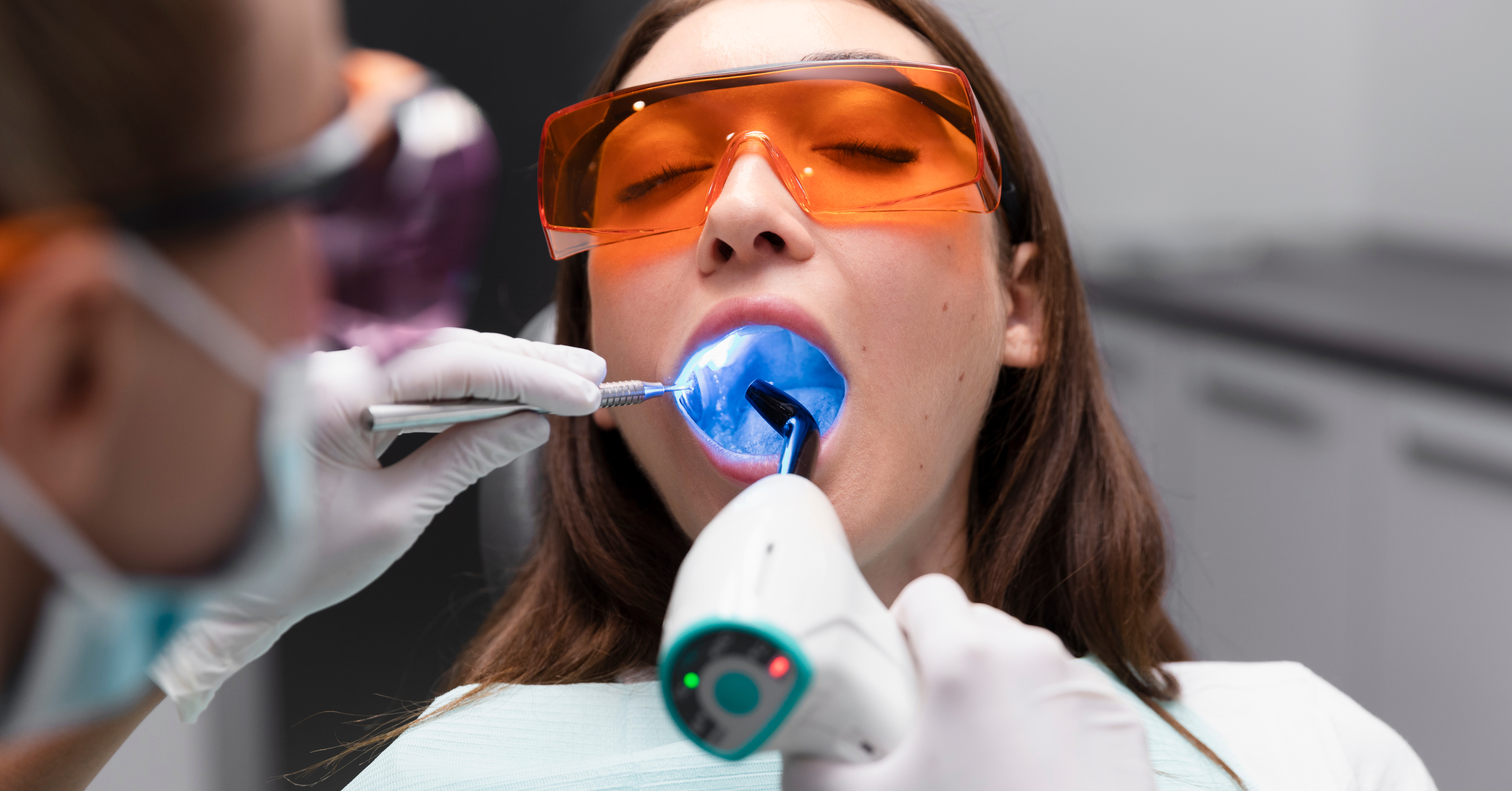
Laser Dentistry vs. Traditional Treatment: Which is Better?
Present-day dental patients pick between laser dentistry and standard dental care when deciding their dental procedures. The medical approaches demonstrate similar results for dental conditions yet display major distinctions between their practiced procedures and pain levels and period of recovery. Traditional dentistry uses drills and mechanical devices and needles as instruments whereas laser dentistry relies on laser beams for precise dental work that causes reduced pain. Being aware of the substantial differences between these two methods helps people base their dental decision on their specific needs. This blog offers a complete comparison between laser dentistry techniques and conventional methods by exploring variables of patient well-being and treatment duration and success rates as well as post-treatment recovery to find the most suitable approach.
What is Laser Dentistry?
Laser dentistry is a modern dental technique using focused light beams, lasers, to treat various dental procedures. Laser energy acts on hard tissue (teeth and bone) and soft tissues (gums) to treat conditions without common dental instruments of drills and scalpels. Laser treatments will act as a cutting or reshaping mechanism depending on the wavelength of the altered delivery of the light energy, and therefore are used to remove caries, decay from a tooth, sterilize infection, oxidize agents on a white or "bleached" tooth, etc. Laser technology may be used in procedures that detect and/or remove cavities, malodorous facets of periodontal diseases, disinfection of root canal procedures, as a whitening process, collection of biopsies, and treatment of dentin hypersensitivity. General benefits of laser dentistry include reduced pain, less bleeding, faster healing and enhanced accuracy, and it may be a strong consideration and useful for dental anxious patients. The lasers also sterilize areas being treated and can significantly reduce a patient's risk of infection. When used by a licensed dental professional, laser dentures is a safe and effective procedural up-to-date dental coffee alternative to common and conventional dental treatment.
Key Benefits of Laser Dentistry:
- Less Pain: Many laser dental treatments can reduce or eliminate the need for anesthesia, resulting in a more comfortable experience for the patient. This makes it an excellent option for those who experience anxiety or fear during dental procedures.
- Faster Healing: Laser treatment causes less tissue trauma, which accelerates the healing process. This means patients experience less discomfort and can return to their normal activities more quickly.
- Less Bleeding: The laser's ability to coagulate blood vessels during procedures helps to minimize bleeding, making the procedure cleaner and reducing the risk of complications.
- More Precise: The precision of lasers allows dentists to target only the affected area, preserving surrounding healthy tissue. This high level of accuracy can lead to more successful outcomes and less disruption to the tooth or gum structure.
What is Traditional Dentistry?
Traditional dentistry is referred to as the orthodox approach to dental care whether it employs manual or typical tools, including dental drills, scalpels, and hand files for standard procedures like cavity fillings, root canals, extractions, and gum surgeries. For many decades, traditional dentistry has been the base of the dental practice, although there are still few clinics that rely solely on traditional dentistry as opposed to laser-assisted dentistry. Treatments in traditional dentistry are typically invasive and often require the use of local anesthesia owing to the concern of pain or discomfort from vibrations, pressure, or incisions being the case. While traditional dentistry is effective treatments where there is typically more bleeding, swelling, extended recovery due to the invasiveness of the tools and processes used, is a serious concern. Diagnosis in traditional dentistry is often made through physical examinations or X-rays. Requiring multiple visits for treatments especially for more complicated cases.
There are still many areas with glaring deficiencies that traditional dentistry will be necessary and reliable on many, particularly those that require better situational surgical precision or are not addressed by current laser systems.
Key Aspects of Traditional Dentistry:
- Requires Anesthesia: Most traditional dental procedures require the use of local anesthesia in the form of injections to numb the treatment area. This can make the patient feel more comfortable during the procedure but may also cause discomfort during the administration of the anesthesia.
- More Invasive: Traditional methods often involve the use of drills or scalpels, which can result in more tissue removal. This can lead to a more invasive procedure, sometimes requiring more extensive recovery time and care.
- Longer Recovery: Due to the more invasive nature of traditional dentistry, healing times are often longer. Patients may experience post-procedure pain, swelling, and discomfort, requiring a few days to recover fully.
- More Bleeding: Traditional dental treatments can cause more bleeding and swelling due to the mechanical nature of the tools used. The removal of tissue during procedures may increase the risk of bleeding, and patients might need more time to manage these effects post-treatment.
Laser Dentistry vs. Traditional Methods: A Side-by-Side Comparison
| Feature | Laser Dentistry | Traditional Dentistry |
|---|---|---|
| Pain | Often no pain, reduced need for anesthesia. | Painful, often requires numbing injections. |
| Healing Time | Faster recovery due to minimal tissue trauma. | Slower recovery with more post-op discomfort. |
| Precision | Highly precise, preserves healthy tissue. | Less precise, often removes more tissue. |
| Risk of Infection | Lower risk, sterilizes as it works. | Higher risk of infection, requires sutures. |
| Comfort | Quieter, less anxiety-provoking. | Noisy drills, more anxiety-inducing. |
| Cost | Generally more expensive due to equipment. | More affordable, established method. |
| Procedure Types | Best for soft and hard tissue procedures. | Suitable for most dental procedures. |
When is Laser Dentistry the Best Option?
Individuals who want better dental treatment may find laser dentistry to be their optimal solution. It is particularly beneficial for:
- Patients with Dental Anxiety: The relaxing dentistry benefits patients experiencing dental anxiety during their dental appointments. The absence of loud drilling equipment along with needle procedures enables laser dentistry to decrease patient stress levels thus improving the tolerability of dental treatments.
- Minor to Moderate Cavities: The laser works perfectly to treat cavities that are neither deep nor large. The procedure eliminates dental decay effectively by targeting specific areas without requiring time-consuming drilling which leaves more of the wholesome tooth material intact. The patient experiences both reduced post-treatment pain and faster healing as a result of this treatment method.
- Gum Treatments: Laser dentistry uses its capabilities to perform soft tissue procedures which include reshaping of gums and gum disease treatment alongside gum tissue reduction. The precise nature of laser technology enables dental procedures to take place without making surgical cuts that results in decreased healing time and decreased bleeding periods.
- Root Canal Therapy: The affected area receives better precision during root canal therapy through the use of laser technology for cleaning and disinfection procedures. The treatment process with lasers produces better results than traditional instruments since the procedures require less invasiveness which leads to shorter healing times and decreased discomfort.
When is Traditional Dentistry Better?
Among the various benefits of laser dentistry certain medical situations make traditional dentistry the optimal choice. Fundamental dental procedures should be used when these conditions apply:
- Severe Tooth Decay: When extensive tooth damage reaches severe levels traditional methods including drilling and filling remain the most suitable treatment option. Severe tooth decay requires traditional methods instead of lasers because laser treatment cannot eliminate decay in advanced stages effectively.
- Wisdom Tooth Extraction: Traditional surgical procedures need to be used when extracting wisdom teeth during complex or impacted cases. Surgical intervention is required to remove wisdom teeth since lasers might lack the needed precision for these procedures.
- Advanced Gum Disease: The efficacy of laser treatment for gum disease ends at mild to moderate conditions because severe periodontal diseases sometimes need traditional surgical methods. Advanced gum disease requires deeper cleaning procedures accompanied by tissue removal and bone reconstruction which traditional treatments administer with greater constructability among the treatment zone.
Laser Dentistry vs. Traditional Methods: Which is Right for You?
In the end, the consideration of laser dental treatment versus traditional dental therapy depends upon your dental needs, procedure being done, and of course your comfort level. With advantages like less pain and quicker healing, laser dentistry may seem attractive to many patients; however, traditional treatment methods are still needed for some more complicated dental procedures.
Conclusion
Both laser and traditional dentistry offer unique benefits. The precision and speed of laser dentistry along with its reduced pain level support treatment outcomes that traditional methods can't match but the traditional methods serve complex dental work needs. Our dental clinic assists clients in selecting appropriate dental treatments depending on their requirements. The clinic operates modern dental facilities equipped with in-house OPG X-rays combined with a 3D diagnostic scanner and single-day restoration capabilities from a 3D printer together with Biolase laser standards for minimally invasive procedures. Each patient receives personalized care along with specialized services highlighted by AI-assisted diagnosis and painless procedures operated from our large private setting with three operation chairs. A luxurious waiting lounge equipped with hospital-grade sterilization along with our commitment to eco-friendly procedures makes our practice dedicated to your comfort and safety and permanent oral health success.
Frequently Asked Questions (FAQs)
- What are the benefits of laser dentistry?
Laser dentistry offers several benefits, including reduced pain, faster recovery, minimal bleeding, and greater precision. It also reduces the need for anesthesia in many cases. - Is laser dentistry more expensive than traditional methods?
Laser dentistry may be more expensive due to the advanced technology and equipment used. However, it can reduce the number of sessions required, which may balance out the cost. - Is laser dentistry safe?
Yes, laser dentistry is highly safe and FDA-approved. It is used by dentists worldwide and offers a minimally invasive option for various dental procedures. - Can laser dentistry be used for fillings?
Yes, laser dentistry is effective for cavity treatment, allowing dentists to remove decay and prepare the tooth for a filling without the need for drilling. - Will laser dentistry work for gum disease treatment?
Laser dentistry is particularly effective for treating gum disease. It helps remove infected tissue and reshapes the gums with minimal discomfort. - How long does it take to recover from laser dental treatments?
Recovery from laser dental treatments is typically faster compared to traditional methods due to minimal tissue disruption. Most patients experience quick healing and less discomfort.

